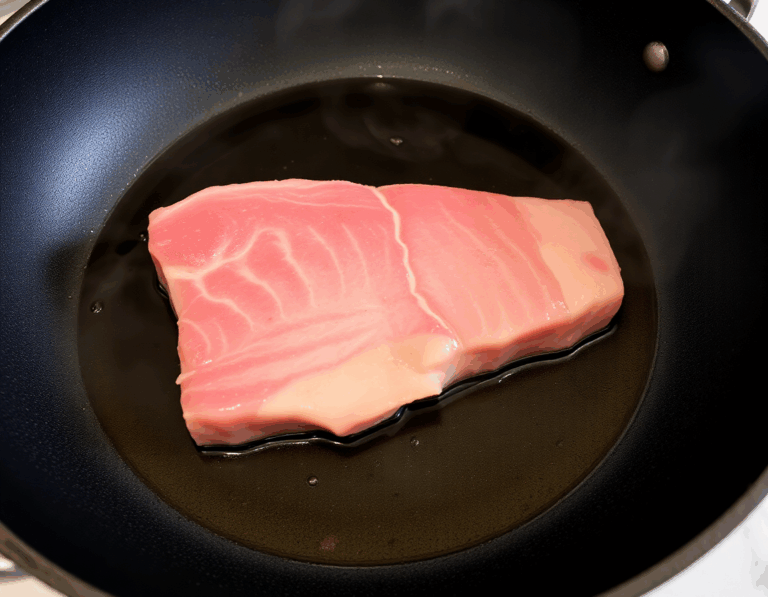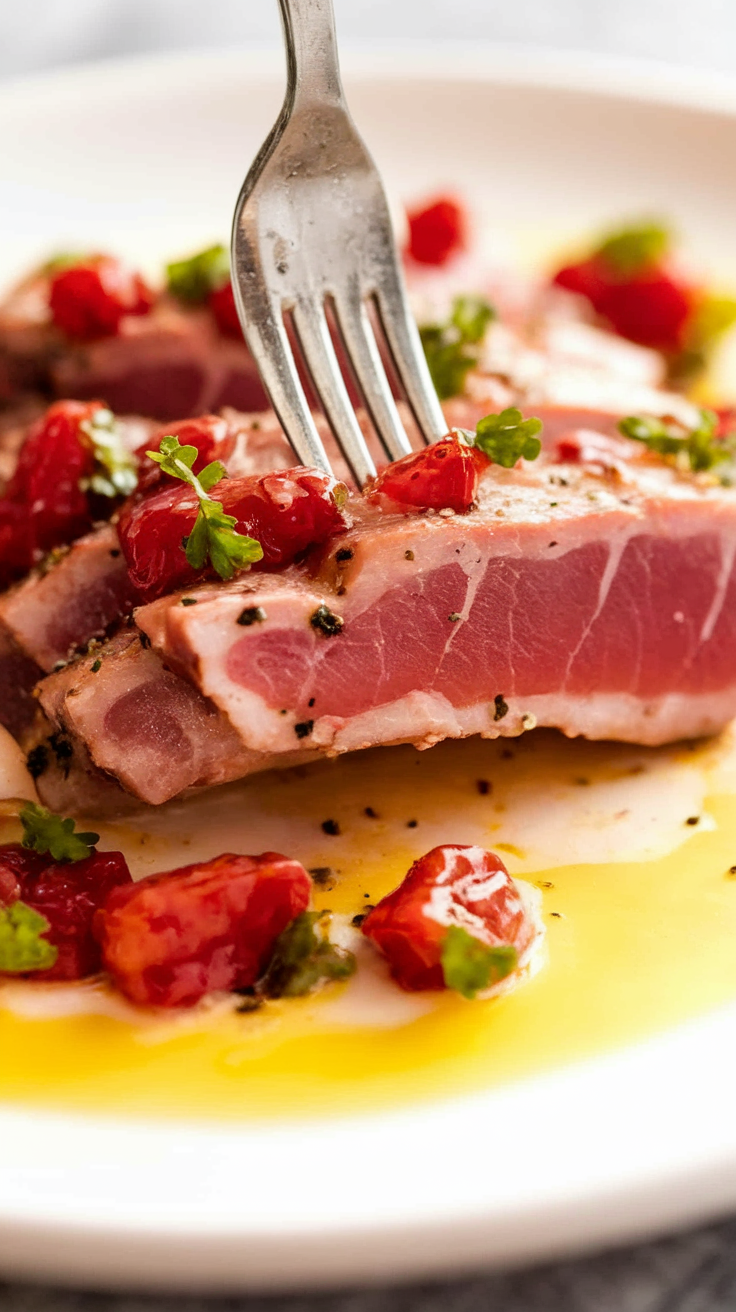Ah, the humble tuna steak—a dish that can transform an ordinary evening into a culinary adventure on the high seas. You know, it’s funny how a simple fish can evoke memories of sunlit beach days and the distant sound of waves crashing, all while sitting in your kitchen. Whether you’re a seasoned chef or just someone who accidentally burned toast this morning, these easy tuna steak recipes promise a delightful escape from the mundane, inviting you to savor each bite like a mini-vacation.
Steps
- Prepare a resting tray by placing a rack on top of a tray.
- Drizzle olive oil over the tuna steaks, then season both sides with salt and pepper.
- Heat a heavy-based skillet on high until it is smoking hot.
- If needed, brush the skillet with oil once hot, ensuring safety by not spraying oil over a lit gas stove.
- Place the tuna steak in the skillet and cook for 45 seconds on one side.
- Rotate the steak 45 degrees to get grill marks and cook for another 45 seconds.
- Flip the tuna and cook the other side for 60 seconds until the internal temperature reaches 48°C (118°F).
- Remove the tuna from the skillet and let it rest on the prepared rack for 5 minutes.
- Optional: Slice the tuna carefully to showcase the seared crust and rare interior.
- Serve the tuna steak, optionally drizzling with a sauce like Sauce Vierge and garnishing with chervil or edible flowers.

Ingredients
- 2 x 180 – 200g (6.5 – 7oz) tuna steaks, skinless and boneless, 2.5-3cm / 1-1.2″ thick
- 1 tsp olive oil
- 1/4 tsp sea salt
- 1/8 tsp black pepper
- 2 tsp olive oil, or oil spray for cooking
- Sauce Vierge (optional serving suggestion)
- Chervil sprigs or small parsley leaves, or small edible flowers (optional garnish)
Nutritional Values
Calories: 416cal | Carbohydrates: 2g | Protein: 70g | Fat: 16g | Saturated Fat: 2g | Trans Fat: 2g | Cholesterol: 130mg | Sodium: 1470mg | Potassium: 648mg | Fiber: 2g | Vitamin A: 206IU | Calcium: 62mg | Iron: 6mg
FAQ
- Should tuna steak be raw in the middle?
- Yes, a well-prepared tuna steak should be seared on the outside and raw on the inside. Tuna loins, which are lean, can become dry if overcooked, so keeping the center rare ensures the meat remains tender and succulent.
- What are the main varieties of tuna used for cooking?
- The primary types of tuna include Yellowfin (commonly used for sashimi and canning), Skipjack (mostly for canned tuna), Albacore (light flesh, also canned), Bluefin (highly prized for its rich flesh, especially in Japan), and Bigeye (valued for its flavor). Ahi tuna is a Hawaiian term that includes both Yellowfin and Bigeye.
- How can you tell if tuna steak is fresh?
- Fresh tuna should smell clean like the ocean, not fishy, and the flesh should be moist but not slimy. Always feel comfortable asking your fishmonger to allow you to check the tuna before purchasing.
- What are some recommended sauces to serve with tuna steak?
- Tuna pairs well with bright and fresh sauces such as Sauce Vierge, Mexican salsa, Salsa Verde, Pesto, Chimichurri Sauce, Japanese Ginger Sauce, and Lemon Vinaigrette, which complement its mild flavor.
- How should tuna steak be cooked for the best results?
- To achieve a perfect sear, use a very hot skillet. Cook a 1-inch thick tuna steak for 90 seconds on the first side and 60 seconds on the other side. The target internal temperature should be 48°C (118°F) to ensure the inside remains rare and warm.
Tips
- Choose Fresh Tuna: Ensure your tuna steak is fresh by checking that it smells clean like the ocean and is moist but not slimy. This is crucial since the steak is best served rare in the center.
- Preheat Skillet Properly: Use a heavy-based skillet and preheat it until it is extremely hot, almost to the point of smoking. This allows you to sear the outside quickly while keeping the inside rare.
- Use a Meat Thermometer: A meat thermometer is highly recommended to ensure the tuna is perfectly cooked. Aim for an internal temperature of 48°C (118°F) for a rare center.
- Resting on a Rack: After cooking, rest the tuna steak on a rack rather than a plate to allow heat to dissipate and minimize carryover cooking, helping to maintain the desired rare doneness.
Equipment
- Cast Iron Skillet with Grill Lines – Essential for achieving the perfect sear and criss-cross grill marks on the tuna steak. A well-seasoned cast iron skillet is ideal for high-heat cooking.
- Meat Thermometer – Highly recommended for ensuring the tuna reaches the perfect internal temperature (48°C / 118°F) while remaining rare inside.
- Rack for Resting – Useful for resting the tuna steak, allowing air circulation to minimize carry-over cooking. A rack set over a tray is suggested.
- Heat-Proof Basting Brush – If you need to oil a skillet, a heat-proof basting brush can be used to apply oil safely.

